|
F4U-1A Corsair
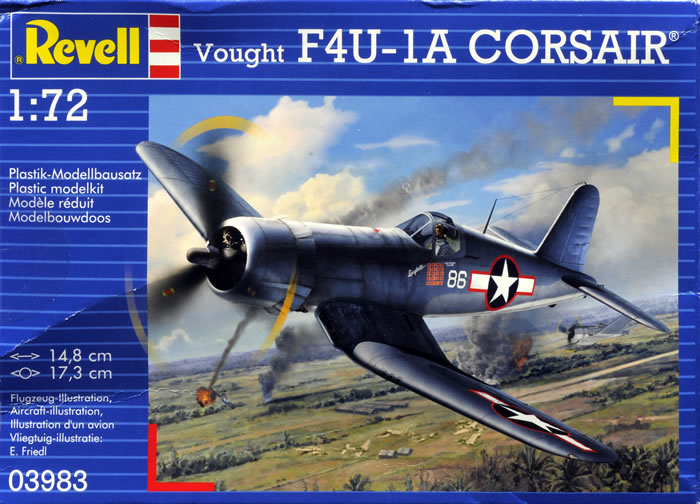
Revell, 1/72 scale
S
u m m a r y |
| Catalogue Number: |
Revell Kit No. 03983 - F4U-1A Corsair |
| Scale: |
1/72 |
| Contents and Media: |
63 white and two clear styrene parts, with decals for two subjects. |
| Price: |
USD$16.14 plus shipping available online from Squadron
£5.42 plus postage available online from Hannants
and stockists worldwide.
Click for currency conversion |
| Review Type: |
FirstLook |
| Advantages: |
Low price, quite good detail, and good quality decals. |
| Disadvantages: |
Seemingly 6% over-length, questionable tailfin shape, dreadful cowl flaps, and some F4U-1D features which are wrong for an F4U-1A (propeller type and twin drop tanks). |
| Conclusion: |
This new Revell tooling will appeal to many people as a well-detailed and very affordable kit, which I think is a fair enough; but what about accuracy?
Whilst it looks like an F4U-1A Corsair I have serious questions about it seemingly being rather over-length (6% by Revell’s own published figure), the shape of its tailfin and rudder, the horizontal stabilizer’s location in relation to the rudder post, slightly large wing leading edge intakes, oversized cowl flaps (that are simply dreadful in their open option form), and the wrong propeller. How does Revell manage this for such a well-know aircraft? There are enough real examples to check, or they could simply have a look at Tamiya’s kits in 1/72, 1/48 and 1/32 scale!
For a cheap easy to build and generally accurate F4U-1A kit, I think I would still opt for the imperfect Academy kit and maybe replace the prop and wheels. I do accept some may prefer the extra detail and cheaper price Revell offers in comparison to this choice however. For a very accurate still easy to build kit I would opt for Tamiya every time. It may be two-and-a-half times Revell’s price, but it’s worth it; and still far from expensive, unless you plan to build a squadron of them.
I’m not a perfectionist, but I wouldn’t buy the Revell kit for myself. However, I can recommend this kit for those who enjoy reasonable detail, good decals, low price, and don’t lose sleep over dimensional and relatively minor shape issues. |
Reviewed by Mark Davies

Revell's 1/72 F4U-1A Corsair is available online from Squadron.com
A Formidable Fighter
The Chance Vought F4U Corsair was an American fighter aircraft that saw service primarily in World War II and the Korean War. Demand for the aircraft soon overwhelmed Vought's manufacturing capability, resulting in production by Goodyear and Brewster: Goodyear-built Corsairs were designated FG and Brewster-built aircraft F3A. From the first prototype delivery to the U.S. Navy in 1940, to final delivery in 1953 to the French, 12,571 F4U Corsairs were manufactured by Vought, in 16 separate models, in the longest production run of any piston-engined fighter in U.S. history (1942–53).
The Corsair was designed as a carrier-based aircraft. However its difficult carrier landing performance rendered the Corsair unsuitable for Navy use until the carrier landing issues were overcome when used by the British Fleet Air Arm. The Corsair thus came to and retained prominence in its area of greatest deployment: land based use by the U.S. Marines. The role of the dominant U.S. carrier based fighter in the second part of the war was thus filled by the Grumman F6F Hellcat, powered by the same Double Wasp engine first flown on the Corsair's first prototype in 1940. The Corsair served to a lesser degree in the U.S. Navy. As well as the U.S. and British use the Corsair was also used by the Royal New Zealand Air Force, the French Navy Aeronavale and other, smaller, air forces until the 1960s. Some Japanese pilots regarded it as the most formidable American fighter of World War II, and the U.S. Navy counted an 11:1 kill ratio with the F4U Corsair.
After the carrier landing issues had been tackled it quickly became the most capable carrier-based fighter-bomber of World War II. The Corsair served almost exclusively as a fighter-bomber throughout the Korean War and during the French colonial wars in Indochina and Algeria.
Source: Wikepedia.
Previous 1/72 F4U-1 Kits
There have been numerous 1/72 F4U kits since the 1950’s; in fact, these 60-plus year old kits are still in production! (Testors re-box of the Hawk kit.) There are many variants of the F4U Corsair, but I shall only mention F4U-1 kits that I am aware of.
- Academy,
- Airfix (re-boxed by Heller & MPC),
- Frog (Re-boxed by Novo & Intech, and possibly Air Lines too),
- Forces of Valour,
- Hasegawa (re-boxed by Minicraft),
- Hawk (re-boxed by Testors),
- Heller (own tooling, re-boxed by Aurora, SMER & MisterCraft),
- Hobby Boss,
- Johan,
- Revell (1963 tooling, re-boxed by Lodella), and
- Tamiya.
Tamiya’s kit is the clear standout of the above list in terms of accuracy and detail, and I have not read any criticisms of the kit. Academy is a popular choice and generally well thought of; labelled an F4U-1, it is in fact a -1A. The prop is a bit undernourished in chord and the cowl a bit blunt, but it builds very easily. Academy’s kit is quite similar to Hasegawa’s (which may well have “influenced” Academy’s tooling), but the Hasegawa’s has fine raised rather than recessed panel detail. I have not looked closely at The Hobby Boss kit, but many of this brand’s efforts in their simple assembly line-up leave me sceptical for now; and on-line images I have seen of finished models have not impressed me. I have not seen the Forces of Valour kit, which is a modern release I think. The others brands in the above list vary in quality and can be hard to obtain, with many being best ignored except for reasons of nostalgia.
Approach to this “First Look”
Rafe Morrissey provided HyperScalers with a most informative and thorough in-box review of the new Revell F4U-1A here in October this year. In fact I felt he made my conducting a routine “First Look” feel rather pointless, as having read his review and looked at my sample I found myself mostly in compete agreement with him. After some thought I felt the most productive way to proceed would be to acknowledge Rafe’s work, summarise his critique here, and then compare the new Revell kit to what I thought are a couple of logical alternatives.
To most adherents of “The One True Scale”, Tamiya’s F4U-1 kits are the benchmark without doubt, and must therefore be included in any comparison. However, Revell’s new tool kit is about 40% of the price of Tamiya’s, so a budget option for comparison is needed too. This had to be a modern kit with recessed panel detail, and feel that Academy’s kit fits this requirement quite well, at around 50% of Tamiya’s price. I could have chosen Hobby Boss at about 30% of Tamiya’s price, but I did not have one to hand, and for now have more faith in the Academy kit’s accuracy.
The Contents
Revell’s contents come packed in a small end-opening box with appealing artwork. The main parts are enclosed in a single plastic bag along with the clear canopy and decal sheet.
The instructions include a parts map and have clear enough assembly diagrams with colour call-outs linked to Revell’s own paint range. The colours and markings diagrams uses full A-4 page monochrome drawings for each colour scheme that clearly indicate where the decals provided should be placed.
The Kit
In general the kit’s moulding is quite crisp and clean. The tooling is obviously intended to accommodate other versions, F4U-1 “Birdcage” and 1-D sub-variants being obvious from the evidence available. Aside from the misshapen seat and a minor control panel issue, internal detail is generally good for the scale, for a closed canopy model at least. The wheel-wells and undercarriage are also nicely executed. The engine is quite reasonable too, given that not much will be visible. I could not help but be left with a feeling that the kit is a bit overly complex in its part breakdown; but it should not be too challenging to build as a result.
I do think many will be mildly impressed by the general feel of detail and quality on offer for a low price. This is a characteristic many new Revell toolings share at glance, only to reveal some real howlers upon closer inspection (need I mention their new Halifax as an example of this?). So what does this new tooling have to reveal?
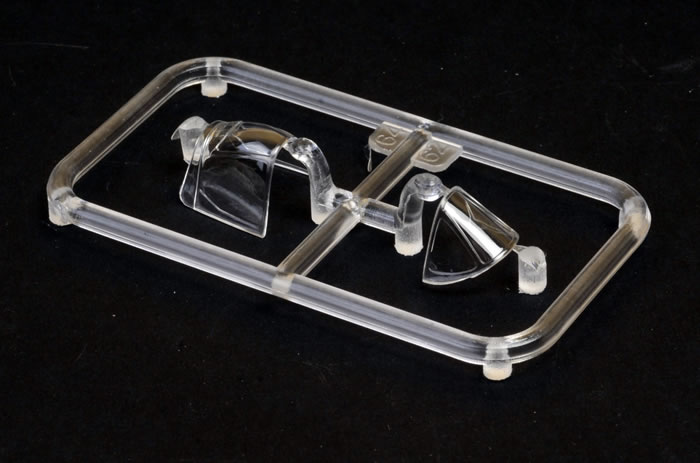
I have done my best to bullet point Rafe’s critique of the kit as follows;
- Moulding in white plastic a poor choice of as detail is hard to see.
- Correctly depicts the Corsair’s floorless cockpit.
- Incorrect centre instrument panel is included beneath the main panel.
- Forward bulkhead is only partially represented instead of spanning the entire width of the fuselage. (However, I think this is compensated for by the mounting points within the fuselage which effectively cover the full width.)
- The seat is the wrong shape and lacks detail.
- Rear bulkhead has cut-outs suitable for an earlier “Birdcage” variant that are incorrect for the F4U-1A.
- The propeller supplied is the later 13’1” paddle blade design; most F4U-1As were fitted with the larger 13’4” version, although some VF-17 aircraft used the later type after field modification.
- The pylons and drop tanks provided in the kit are only applicable to the F4U-1D.
- The open cowl-flap option lacks the spacers to fill to openings between each of the flaps.

- The outline of the kit looks consistent with Rafe’s references. (I’m less content about accuracy; see later...)
- The fit is generally good, but the cowling does not appear to fit well at all, and the design is overly complex and clunky.
- The separate wing tips (to allow for an FAA clipped-wing option) will require the use of filler.
- The decals are well-printed with good registration and colour, but the front gear numbers for the famous “Lucybelle” propaganda mount of Maj. Gregory “Pappy” Boyington are wrong, being 883 instead of 86; 883 was the side number for an F4U-1A that Boyington actually flew in combat.
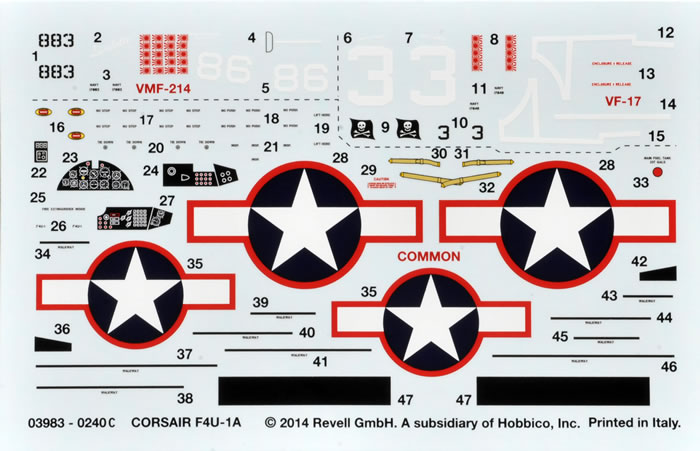
- The price is right, and experienced Corsair fans will be able to handle the detail challenges posed by this kit without too much trouble.
To the above I would add these observations:
- The ventral exhaust stacks are very nicely done, and the best in the scale I have seen.
- The inclusion of a seat harness on the decals sheet is a plus in my view - Just cut it out with the paper backing in place to give it some “meat” to the belts, paint the paper and glue to the seat.
- The gun muzzle blast holes in the leading edge are separate parts, ensuring perfectly round holes; the trade off being a small seam to deal with surrounding the insert. The holes also look a little small to me as well, but can easily be enlarged.
- Surface detail is refined, and although the fabric surfaces are exaggerated in effect (as are most F4U-1 to -4 kits in my view to some degree). I could probably live with Revell’s representation after a few coats of Mr. Surfacer had been applied to them.
- The quality of the decals is a huge improvement on the nasty matt finish ones that were a feature of Revell kits for years.
- The kit has an overly complex parts breakdown. This may be in part to allow for other variants to be kitted, but some things seem just unnecessary; such as the multiple cowl parts, the separate fin on the starboard fuselage half, and the separate upper decking to the forward fuselage. This last feature may be designed to avoid a seam-line running through the fuel tank filler.
- The smaller diameter prop, suitable for an F4U-1D, is a pity; it’s not a standout, but now Rafe’s review has drawn my attention to it I can’t ignore it!
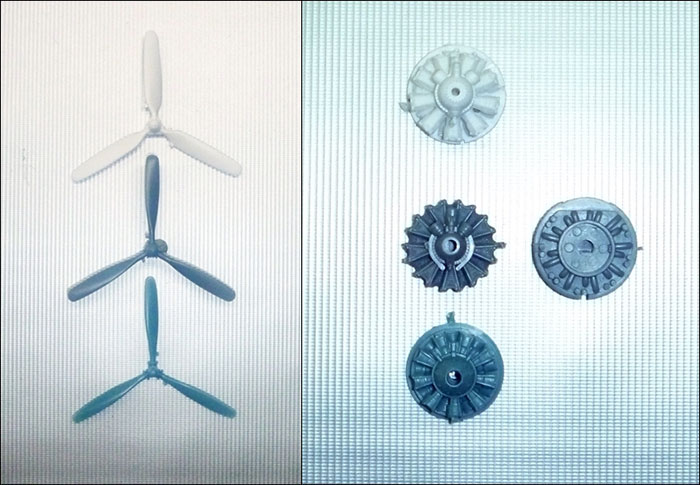
- Revell’s own website lists Kit 03983 as an F4U-1D rather than an F4U-1A as per the box; which might explain something about their attention to detail and the -1D features present in this kit!
- A minor point, but the F4U-1A introduced a small wedge shaped spoiler to the leading edge of the starboard wing to make the starboard wing stall at the same time as the port one to improve landing behaviour; this wedge is absent.
- The F4U-1A introduced a centreline Brewster 1,000lb bomb rack during its production run*, again this is absent. Instead, the locating indents for the two drop-tank pylons that are supplied, which are not an F4U-1A feature, need to be filled in. The F4U-1 and -1A could be fitted with a small 100lb bomb rack just outboard of the guns on each wing. These were not often used, and the kit does not provide them.
* From F4U-1A BuNo. 17930, and FG-1A BuNo. 13572 onwards. These aircraft were also plumbed for the carriage of a 170 gallon fuel tank on the centreline, but BuNo. records do not exist for when drop-tank plumbing was introduced on Brewster-built F3A’s. Some earlier aircraft had field-modification centreline bomb-racks fitted.
Comparison to the Tamiya & Academy F4U-1A Kits
I have included some images of the Revell, Tamiya and Academy kit parts aligned against each other, with them appearing in this order top to bottom in most cases. Revell’s plastic is white, Tamiya’s grey, and Academy’s a blue-grey. I apologise for the less than perfect photography; taking pictures of white parts is not easy.
In comparing Revell’s kit to the Tamiya benchmark I found that the:
- Rear fuselage is about 3mm longer, which is a scale 210mm or 8.5”. It has the effect of putting the tailfin further back in relation to the cockpit. (The Tamiya and Academy fuselages are essentially the same.) Many references quote the F4U-1A as being 33 feet 4 inches long, or near enough to 10.1 metres. This equates to 140.3mm in 1/72 scale, yet Revell states on the box and its website that its model is 148mm long, equal to a full size of 34 feet 11.5 inches, or 10.66 metres; which by their own reckoning is 6% over-length, However, Revell’s wingspan figure agrees with a scale equivalent of 41 feet or 10.49 metres.
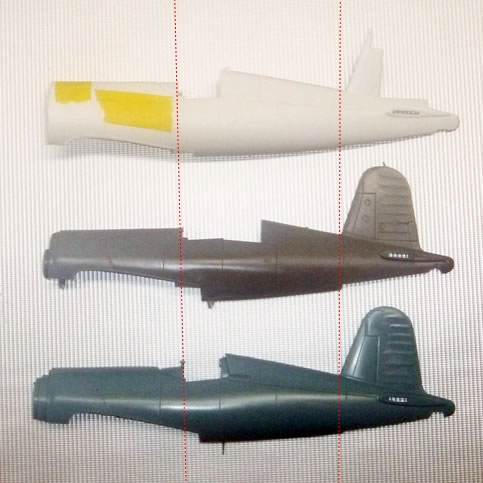
- The combined fin and rudder shape looks a bit short in height and broad in chord.
- Cowl flaps are oversized in chord, both in their “toothy” open and closed forms. What is about Revell and engine cowling shapes? Their Lancaster, Halifax and now this... Surely, a quick glance at photos or a competitor’s product (Hobby Boss aside, which has the same affliction) would have revealed how wrong the cowl flaps are.
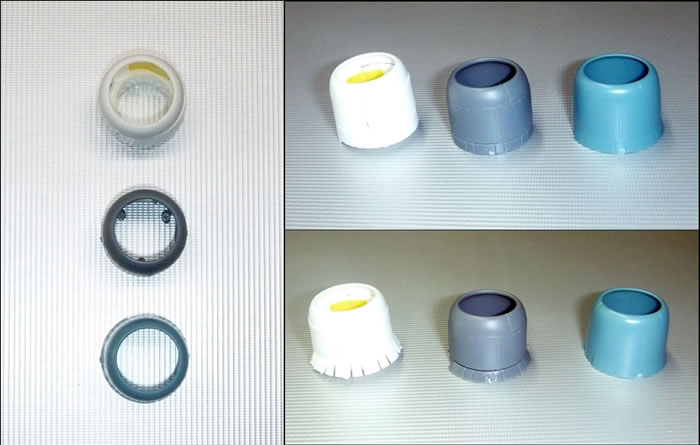
- Air intakes in the wing leading edges appear to be a bit oversized (but their shape is better than Academy’s).
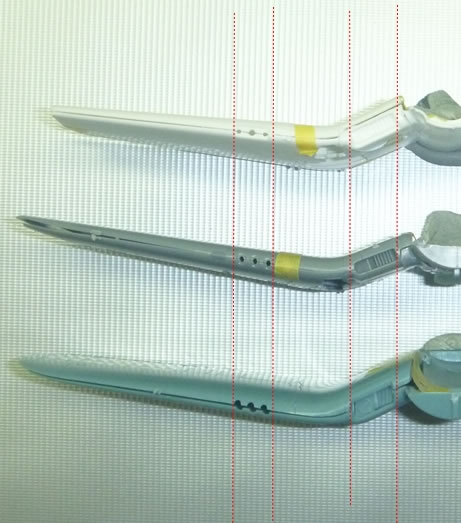
- Horizontal stabiliser is further back than the Tamiya kit’s is (and Academy’s too); not just because of extra rear fuselage length, but also in the relationship between its leading edge and the rudder post.

- The wing’s fabric area does not extend in a small panel past the aileron in line with about 40% of the outboard fabric-covered flap’s span (behind the ammo-boxes); instead the panel is moulded to represent metal. Like Tamiya’s, the Academy kit has fabric in this area. Various plans I checked conflict in this area, and actual photos are incredibly hard to judge due to lighting, paint weathering, and the tightness of actual fabric; I can’t say which is correct, but would bet my money on Tamiya.
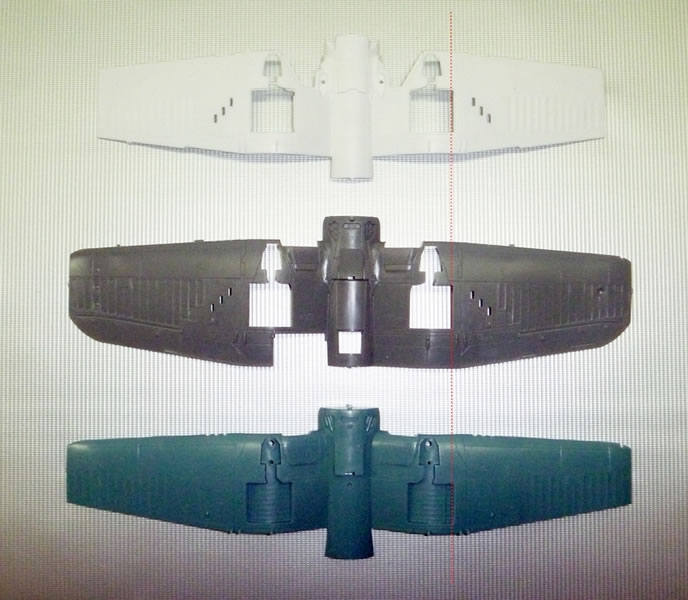
Academy’s kit in comparison to Tamiya’s is a largely a case of simpler detail, fewer parts, an undernourished propeller chord, a cowl leading edge that is not quite round enough, and undersized main-wheels; all for half the price.
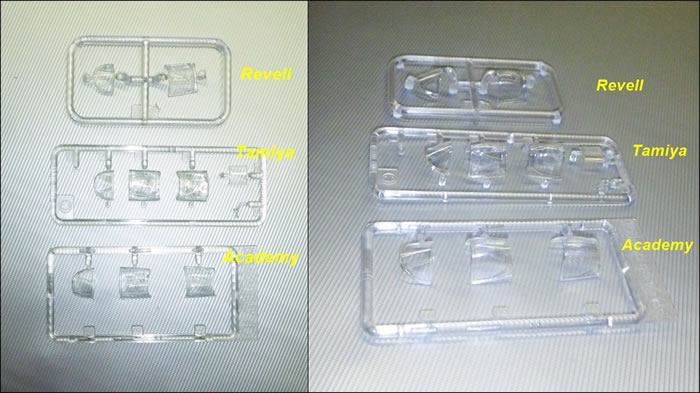
I have built one, and found it to be a very simple kit with good fit. However, I would still pay the extra and opt for Tamiya in the future.
This new Revell tooling will appeal to many people as a well-detailed and very affordable kit, which I think is a fair enough; but what about accuracy?
Whilst it looks like an F4U-1A Corsair I have serious questions about it seemingly being rather over-length (6% by Revell’s own published figure), the shape of its tailfin and rudder, the horizontal stabilizer’s location in relation to the rudder post, slightly large wing leading edge intakes, oversized cowl flaps (that are simply dreadful in their open option form), and the wrong propeller.
How does Revell manage this for such a well-know aircraft? There are enough real examples to check, or they could simply have a look at Tamiya’s kits in 1/72, 1/48 and 1/32 scale!
For a cheap easy to build and generally accurate F4U-1A kit, I think I would still opt for the imperfect Academy kit and maybe replace the prop and wheels. I do accept some may prefer the extra detail and cheaper price Revell offers in comparison to this choice however, for a very accurate still easy to build kit, I would opt for Tamiya every time. It may be two-and-a-half times Revell’s price, but it’s worth it; and still far from expensive, unless you plan to build a squadron of them.
I’m not a perfectionist, but I wouldn’t buy the Revell kit for myself. However, I can recommend this kit for those who enjoy reasonable detail, good decals, low price, and don’t lose sleep over dimensional and relatively minor shape issues.
Revell model kits are available from all good toy and model retailers. For details visit www.revell.de/en, @RevellGermany or facebook.com/Revell
Review Text and Images Copyright © 2014 by Mark Davies
Page Created 10 December, 2014
Last updated
10 December, 2014
Back to HyperScale Main Page
Back to Reviews Page |
